Managing diabetes doesn’t mean sacrificing flavor or enjoyment in your meals. In fact, with the right approach, you can create delicious dishes that not only satisfy your cravings but also help keep your blood sugar levels in check. This article presents a variety of healthy recipes for diabetics, designed to meet nutritional needs while offering great taste.
Key Components of Healthy Recipes for Diabetics
Healthy recipes for diabetics should prioritize the following components:
Low Glycemic Index
The glycemic index (GI) is a measure of how quickly a food raises your blood sugar levels after eating it. Foods with a low glycemic index are digested and absorbed more slowly, leading to a gradual rise in blood sugar rather than a rapid spike.
By choosing low-GI foods, such as whole grains, legumes, and non-starchy vegetables, you can help keep your blood sugar levels more stable throughout the day. This stability is crucial for managing diabetes effectively, as it reduces the risk of blood sugar highs and lows.
Balanced Meals
A balanced meal includes a good mix of macronutrients—protein, fiber, and healthy fats. Protein helps build and repair tissues and is digested more slowly than carbohydrates, which helps in maintaining stable blood sugar levels. (Read more: Easy High-protein Meals with 10 Delicious Recipes)
Fiber, found in vegetables, fruits, and whole grains, slows down the absorption of sugar into the bloodstream and promotes a feeling of fullness, reducing the likelihood of overeating.
Healthy fats, such as those found in avocados, nuts, and olive oil, also contribute to satiety and help regulate blood sugar. Together, these nutrients work to provide sustained energy and prevent the rapid fluctuations in blood sugar that can occur with high-carb, low-fiber meals.
Portion Control
Eating the right portion sizes is key to managing blood sugar levels and avoiding overeating. Large portions, especially carbohydrate-rich foods, can lead to excessive calorie intake and cause a sharp rise in blood sugar.
By controlling portion sizes, you can better regulate your blood sugar and maintain a healthy weight, which is essential for diabetes management. Smaller, well-balanced meals throughout the day can help keep your blood sugar stable and prevent the hunger that can lead to overeating.
Nutrient-Dense Foods
Nutrient-dense foods are those that provide a high amount of vitamins, minerals, and other essential nutrients relative to their calorie content. These foods, such as leafy greens, berries, nuts, and seeds, not only support overall health but also play a role in managing diabetes.
For example, antioxidants found in nutrient-dense foods can help reduce inflammation, which is often linked to insulin resistance and other complications of diabetes.
By focusing on nutrient-dense foods, you’re not just managing your blood sugar—you’re also giving your body the nutrients it needs to function optimally, supporting your immune system, and promoting long-term well-being.
Read more:
Healthy Recipes For Diabetics
Here are nine diabetic-friendly recipes that are both tasty and beneficial for managing diabetes:
1. Low-Carb Vegetable Stir-Fry
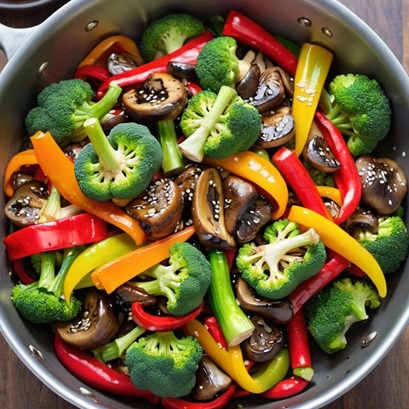
- Ingredients: Bell peppers, broccoli, zucchini, mushrooms, garlic, soy sauce, sesame oil.
- Instructions: Sauté garlic in sesame oil, add chopped vegetables, and stir-fry until tender. Season with soy sauce and serve hot.
This dish is low in carbohydrates and packed with fiber and vitamins, helping to maintain stable blood sugar levels.
2. Grilled Chicken with a Side of Roasted Vegetables
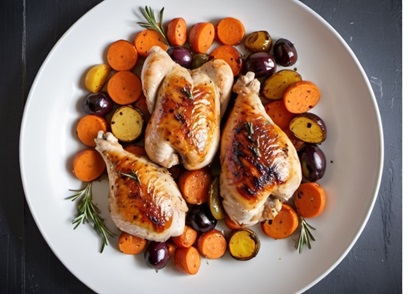
- Ingredients: Chicken breast, olive oil, garlic, rosemary, mixed vegetables (e.g., carrots, Brussels sprouts).
- Instructions: Marinate chicken with olive oil, garlic, and rosemary. Grill until cooked through. Roast vegetables in the oven with a drizzle of olive oil and herbs. (Read more: 10 Must-have Herbs for Health)
The lean protein in chicken paired with fiber-rich vegetables makes this meal perfect for blood sugar control.
3. Quinoa Salad with Leafy Greens and Nuts
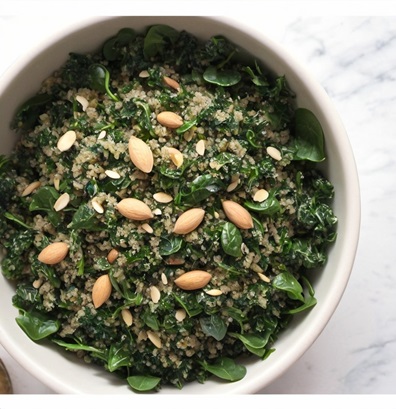
- Ingredients: Quinoa, spinach, kale, almonds, lemon juice, olive oil.
- Instructions: Cook quinoa and let it cool. Toss with fresh greens, chopped nuts, lemon juice, and olive oil.
Quinoa is a whole grain with a low glycemic index, and the addition of leafy greens and nuts provides essential nutrients and healthy fats.
4. Baked Fish with a Citrus Glaze

- Ingredients: White fish fillet, lemon juice, orange zest, olive oil, garlic.
- Instructions: Brush the fish with olive oil, lemon juice, and orange zest. Bake until flaky and tender.
Fish is an excellent source of lean protein and omega-3 fatty acids, which are beneficial for heart health.
5. Lentil Soup with Fresh Herbs

- Ingredients: Lentils, onions, carrots, celery, garlic, thyme, bay leaves.
- Instructions: Sauté vegetables, add lentils and herbs and simmer until the lentils are tender.
Lentils are high in fiber and have a low glycemic index, making them ideal for blood sugar management.
6. Zucchini Noodles with Lean Protein
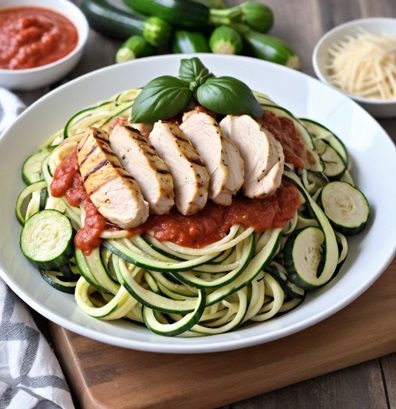
- Ingredients: Zucchini, grilled chicken or turkey, marinara sauce, Parmesan cheese.
- Instructions: Spiralize zucchini into noodles, sauté until tender, and top with grilled protein and marinara sauce.
Zucchini noodles are a low-carb alternative to pasta, and adding lean protein ensures a balanced, satisfying meal.
7. Mediterranean-Style Stuffed Peppers
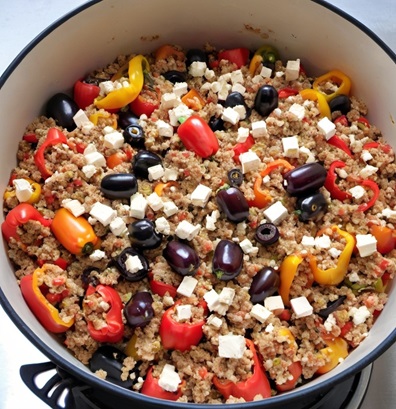
- Ingredients: Bell peppers, quinoa, ground turkey, tomatoes, olives, feta cheese.
- Instructions: Cook quinoa and ground turkey, mix with tomatoes, olives, and feta, then stuff into bell peppers and bake.
This dish is rich in fiber, protein, and healthy fats, offering a balanced meal that supports blood sugar control.
8. Chia Seed Pudding with Unsweetened Almond Milk

- Ingredients: Chia seeds, unsweetened almond milk, vanilla extract, berries (optional).
- Instructions: Mix chia seeds with almond milk and vanilla extract, and let sit overnight in the fridge. Top with berries if desired.
Chia seeds are high in fiber and omega-3 fatty acids, helping to slow down the absorption of sugar and keep you full longer. (Read more: Why You Should Add Chia Seeds to Your Diet)
9. Avocado and Bean Salad with a Lemon Dressing
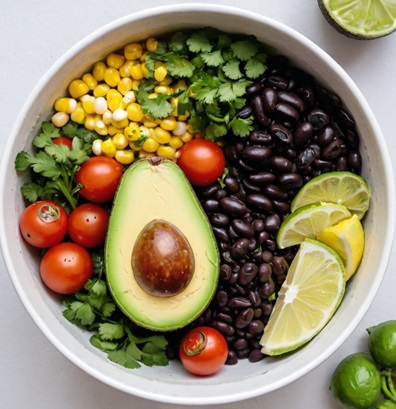
- Ingredients: Avocado, black beans, corn, cherry tomatoes, lemon juice, cilantro.
- Instructions: Toss all ingredients together with fresh lemon juice and cilantro. (Read more: Why Avocados Can Reduce Inflammation)
Avocados provide healthy fats, while beans add fiber and protein, making this a nutrient-dense and satisfying dish.
Importance of Diet in Managing Diabetes
A well-balanced diet is one of the most important tools for managing diabetes effectively. The types of foods you eat and how you combine them can have a significant impact on your blood sugar levels, energy levels, and overall health.
For example, carbohydrates are broken down into sugar in your body, which can raise blood sugar levels. By choosing meals that are low in carbohydrates and high in fiber, you can slow down this process, helping to keep your blood sugar more stable throughout the day.
Eating balanced meals means including a mix of proteins, healthy fats, and plenty of fiber-rich foods like vegetables and whole grains. This combination helps to prevent rapid spikes in blood sugar and provides steady energy. It also aids in managing your weight, which is crucial for diabetes management.
By consistently incorporating diabetic-friendly meals into your daily routine, you can better maintain stable blood sugar levels, which reduces the likelihood of experiencing dangerous highs and lows.
Additionally, a balanced diet can help lower the risk of long-term complications related to diabetes, such as heart disease, kidney damage, and nerve issues. This approach to eating not only helps you manage diabetes day-to-day but also contributes to your overall well-being and long-term health.
Conclusion
Incorporating healthy recipes into your diabetes diet can be both enjoyable and beneficial. These recipes are designed to satisfy your cravings without compromising your health. By focusing on balanced meals, low glycemic index foods, and proper portion control, you can manage your diabetes effectively while enjoying delicious and nutritious meals. Whether you’re preparing a quick stir-fry or indulging in a chia seed pudding, these diabetic-friendly meals are sure to help you maintain good blood sugar control and overall wellness.


